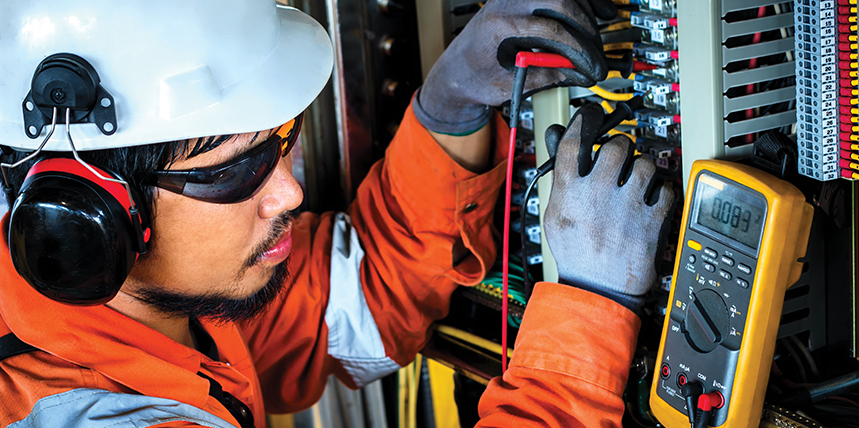The purpose of using temporary protective grounds is to protect personnel servicing the equipment and to create a safe work environment. Before servicing a piece of electrical equipment, it is important to ensure that it is in a safe state and to verify zero voltage before applying temporary protective grounds. In many situations, more than one set of grounds or grounding apparatus must be applied.
When identifying the placement of temporary protective grounds, ensure all work will be performed within the zone of protection. For proper placement and sizing of temporary protective grounds and grounding apparatus, refer to OSHA 29 CFR 1910.269, Electric Power Generation, Transmission and Distribution. Under paragraph (n) Grounding for the Protection of Employees, this standard states:
1910.269(n)(1)
Application. Paragraph (n) of this section applies to grounding of generation, transmission, and distribution lines and equipment for the purpose of protecting employees. Paragraph (n)(4) of this section also applies to protective grounding of other equipment as required elsewhere in this section.
Note to paragraph (n)(1): This paragraph covers grounding of generation, transmission, and distribution lines and equipment when this section requires protective grounding and whenever the employer chooses to ground such lines and equipment for the protection of employees.
1910.269(n)(2)
General. For any employee to work transmission and distribution lines or equipment as de-energized, the employer shall ensure that the lines or equipment are de-energized under the provisions of paragraph (m) of this section and shall ensure proper grounding of the lines or equipment as specified in paragraphs (n)(3) through (n)(8) of this section. However, if the employer can demonstrate that installation of a ground is impracticable or that the conditions resulting from the installation of a ground would present greater hazards to employees than working without grounds, the lines and equipment may be treated as deenergized provided that the employer establishes that all of the following conditions apply:
1910.269(n)(2)(i)
The employer ensures that the lines and equipment are deenergized under the provisions of paragraph (m) of this section.
1910.269(n)(2)(ii)
There is no possibility of contact with another energized source.
1910.269(n)(2)(iii)
The hazard of induced voltage is not present.
1910.269 then states under (n)(4) Protective Grounding Equipment:
Protective grounding equipment shall be capable of conducting the maximum fault current that could flow at the point of grounding for the time necessary to clear the fault.
Protective grounding equipment shall have an ampacity greater than or equal to that of No. 2 AWG copper.
Protective grounds shall have an impedance low enough so that they do not delay the operation of protective devices in case of accidental energizing of the lines or equipment.
PPE REQUIREMENTS WHEN INSTALLING TEMPORARY PROTECTIVE GROUNDS
Any work on or near exposed energized equipment that encroaches within the restricted approach boundary or the arc flash protection boundary requires some form of additional personal protection. The level of protection depends on the incident energy level and proximity to the circuit. A current copy of NFPA 70E, Standard for Electrical Safety in the Workplace should be referenced prior to beginning the grounding operation at any commercial location.
Additionally, reference the arc flash analysis of the equipment to be grounded if supplied. In power generation, transmission, and distribution facilities, reference OSHA CFR 1910.269.
For our example, we assume a commercial operation that does not have an analysis, or we are double-checking the analysis provided.
The first step in determining the required PPE is to calculate the applicable arc flash incident energy of the equipment. If you cannot do this, use the applicable tables in NFPA 70E to determine the likelihood and severity of an arc. Also reference the tables when applying protective grounds onto a circuit comprised of the same equipment within the same voltage range. When using the tables, take notice of the notes at the end of the tables because they may change the requirements of PPE required to perform the task.
It is important to note that the table terminology in NFPA 70E has coincided with OSHA 1910.269 since the .269 rewrite in 2009. The table states that the grounds are “temporary protective” grounds and that it is being done “after voltage test.” This means that even in the presence of zero voltage, the application of grounds must be done while wearing arc flash PPE at the appropriate level for the hazard and incident energy level, with rubber insulating gloves as a means of protecting the personnel. Table 1 shows the required PPE for hazard risk Category 4.
Applying the clamp to the grounded side can be achieved without the use of the full level of PPE unless encroaching within the approach distance of some piece of equipment. Clamping the ground to equipment that has been removed from service and de-energized should be accomplished using a shotgun stick while wearing the required and indicated PPE for the task and incident energy level.
The notes below the table for the PPE state:
If rubber insulating gloves with leather protectors are used, additional leather or arc-rated gloves are not required. The combination of rubber insulating gloves with leather protectors satisfies the arc flash protection requirement.
Because of this, it is advisable to wear rubber insulating gloves and protectors.
RECOMMENDED PRACTICES
Here are some valuable steps that should be taken prior to commencing work:
- Be familiar with the equipment being serviced.
- Check drawings and one-line diagrams.
- Walk the site to identify any physical hazards.
- Check the equipment for a recent arc flash hazard analysis
- Write a switching and tagging order or utilize the lockout/tag-out (LOTO) procedure specific to the equipment.
- Write a job hazard analysis and/or a prejob brief, identifying all site- and
task-specific hazards. - Discuss the prejob briefing with co-workers and ask if they have any insight into past successes or failures in dealing with similar tasks.
- Put on the required level of PPE after verifying that the task has a known or calculated hazard/risk category. Ensure that no additional PPE will be necessary when applying protective grounds.
- De-energize equipment.
- Verify that the voltage testing device is functional against a known source.
- Verify zero voltage and have someone double-check it.
- Reverify that the test device is functional against a known source.
- Apply the grounding side of the clamp and ensure it is No. 2 AWG or larger ground cable.
- Apply grounds to the equipment utilizing a reach or remote method, like a shotgun stick.
- Remove the PPE when the task is complete.
CONCLUSION
Refer to industry standards from NFPA or OSHA as necessary and wear the required PPE when installing temporary protective grounds. Be safe; when in doubt, always err on the side of caution.
REFERENCES
[1] OSHA Standards for General Industry. 29 CFR Part 1910.269, Electric Power Generation, Transmission, and Distribution. [2] National Fire Protection Association. NFPA 70E, Standard for Electrical Safety in the Workplace.
Paul Chamberlain has been the Safety Manager for American Electrical Testing Co. LLC since 2009. He has been in the safety field since 1998, working for various companies and in various industries. Paul received a BS from the Massachusetts Maritime Academy.
